McDonald's Success in Poland: Leadership, Management and CSR
VerifiedAdded on 2024/06/03
|11
|2698
|468
Report
AI Summary
This report provides an overview of McDonald's business and management strategies in Poland, focusing on the leadership of CEO Adam Pienkowski and the company's success in the Polish market. It identifies and explains the three levels of organizational management, their responsibilities, and associated functional areas, along with a comparison of vertical and horizontal structures. The report also examines various leadership and management models, such as autocratic, people-based, democratic, classical, human relations, neo-human relations, and system models, and their application within McDonald's. Furthermore, it discusses the effects of globalization on the organization, including professional development and the use of innovative methods to target a vast population. Finally, the report explains the concept of Corporate Social Responsibility (CSR) and reviews two specific CSR initiatives adopted by McDonald's in Poland, including their contributions to the Polish economy and their efforts to empower the younger generation, leading to the expansion of the restaurant chain across the nation. This analysis highlights how McDonald's adapts global strategies to local contexts, fostering customer trust and business growth.
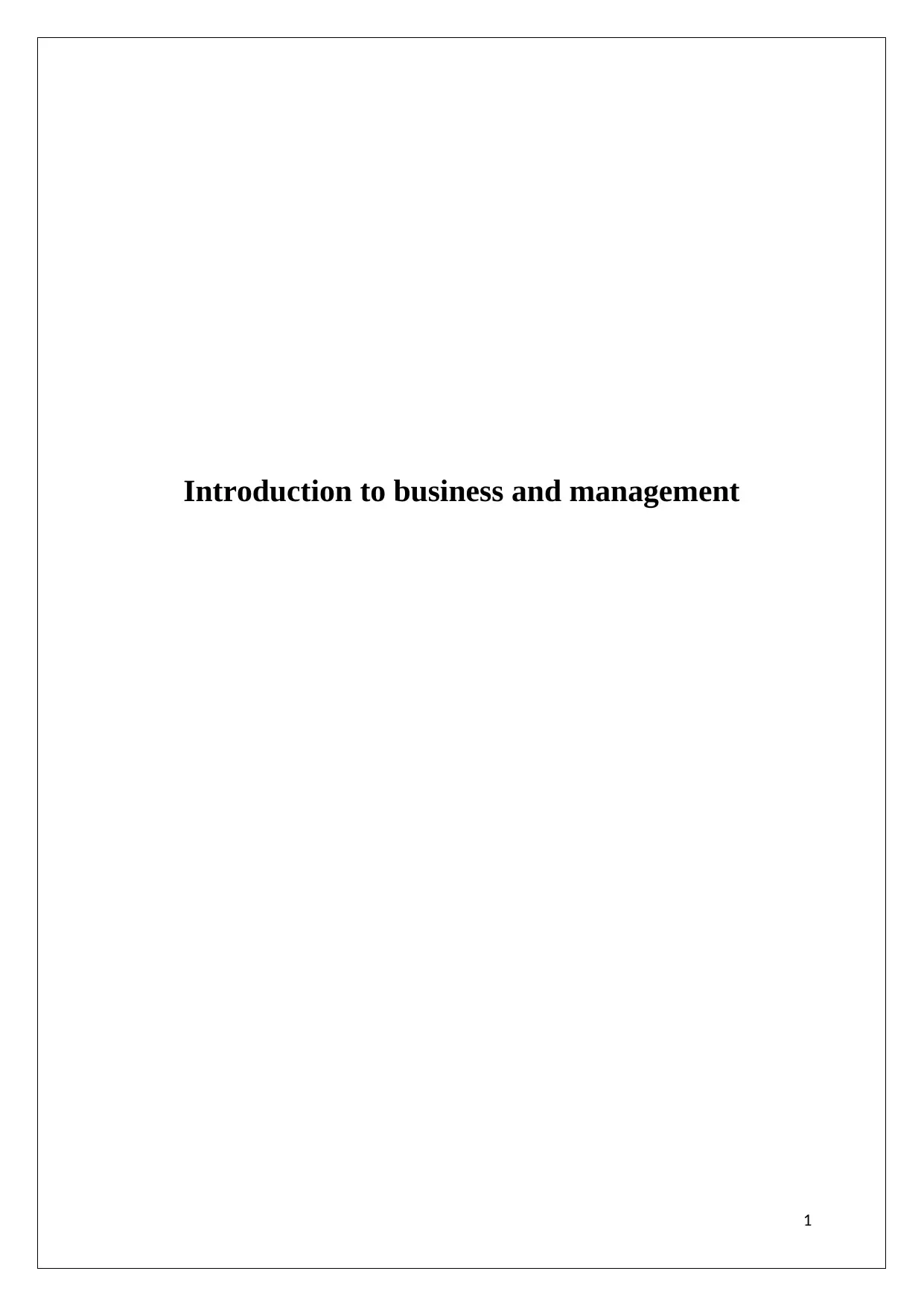
Introduction to business and management
1
1
Paraphrase This Document
Need a fresh take? Get an instant paraphrase of this document with our AI Paraphraser
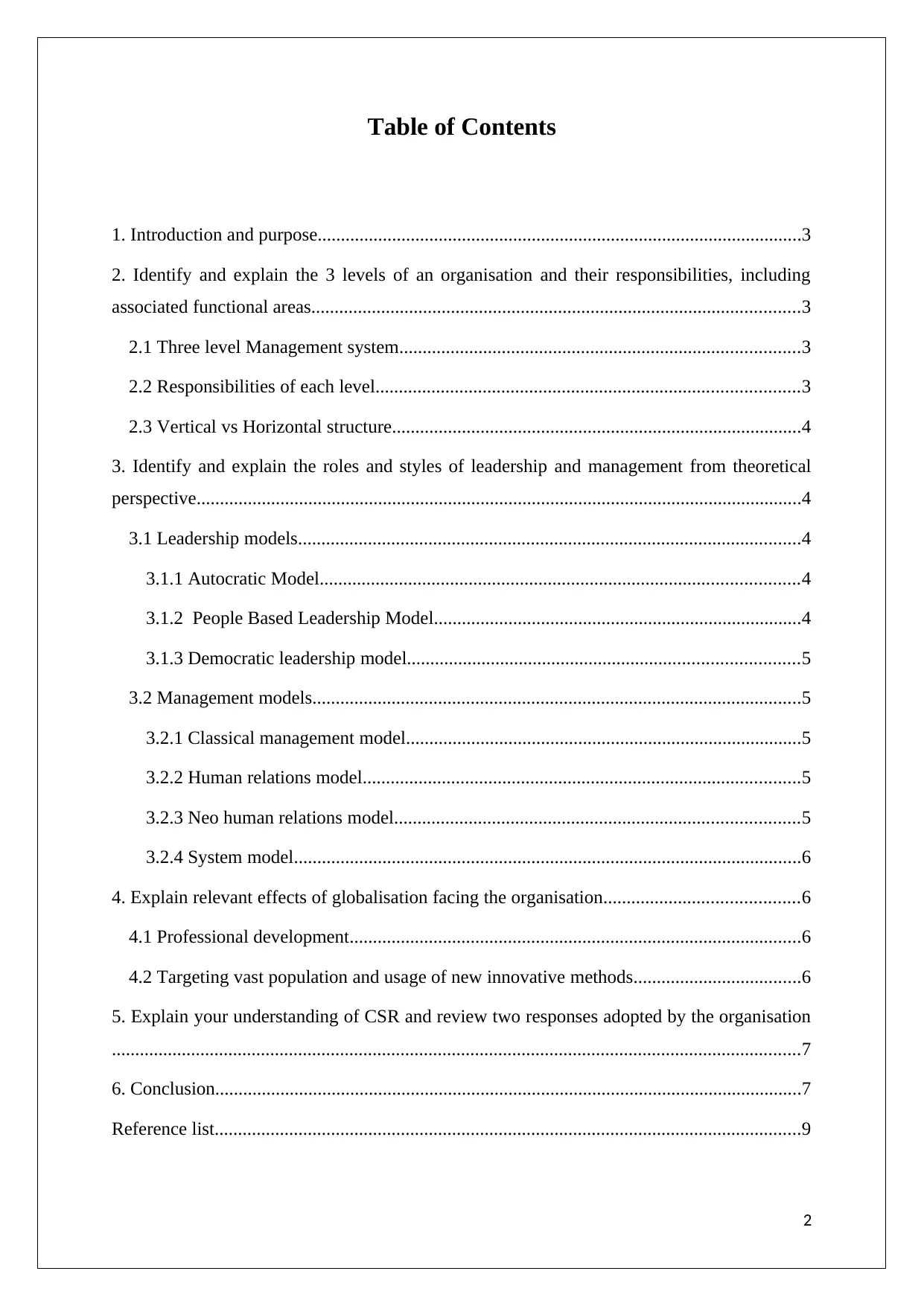
Table of Contents
1. Introduction and purpose........................................................................................................3
2. Identify and explain the 3 levels of an organisation and their responsibilities, including
associated functional areas.........................................................................................................3
2.1 Three level Management system......................................................................................3
2.2 Responsibilities of each level...........................................................................................3
2.3 Vertical vs Horizontal structure........................................................................................4
3. Identify and explain the roles and styles of leadership and management from theoretical
perspective..................................................................................................................................4
3.1 Leadership models............................................................................................................4
3.1.1 Autocratic Model.......................................................................................................4
3.1.2 People Based Leadership Model...............................................................................4
3.1.3 Democratic leadership model....................................................................................5
3.2 Management models.........................................................................................................5
3.2.1 Classical management model.....................................................................................5
3.2.2 Human relations model..............................................................................................5
3.2.3 Neo human relations model.......................................................................................5
3.2.4 System model.............................................................................................................6
4. Explain relevant effects of globalisation facing the organisation..........................................6
4.1 Professional development.................................................................................................6
4.2 Targeting vast population and usage of new innovative methods....................................6
5. Explain your understanding of CSR and review two responses adopted by the organisation
....................................................................................................................................................7
6. Conclusion..............................................................................................................................7
Reference list..............................................................................................................................9
2
1. Introduction and purpose........................................................................................................3
2. Identify and explain the 3 levels of an organisation and their responsibilities, including
associated functional areas.........................................................................................................3
2.1 Three level Management system......................................................................................3
2.2 Responsibilities of each level...........................................................................................3
2.3 Vertical vs Horizontal structure........................................................................................4
3. Identify and explain the roles and styles of leadership and management from theoretical
perspective..................................................................................................................................4
3.1 Leadership models............................................................................................................4
3.1.1 Autocratic Model.......................................................................................................4
3.1.2 People Based Leadership Model...............................................................................4
3.1.3 Democratic leadership model....................................................................................5
3.2 Management models.........................................................................................................5
3.2.1 Classical management model.....................................................................................5
3.2.2 Human relations model..............................................................................................5
3.2.3 Neo human relations model.......................................................................................5
3.2.4 System model.............................................................................................................6
4. Explain relevant effects of globalisation facing the organisation..........................................6
4.1 Professional development.................................................................................................6
4.2 Targeting vast population and usage of new innovative methods....................................6
5. Explain your understanding of CSR and review two responses adopted by the organisation
....................................................................................................................................................7
6. Conclusion..............................................................................................................................7
Reference list..............................................................................................................................9
2
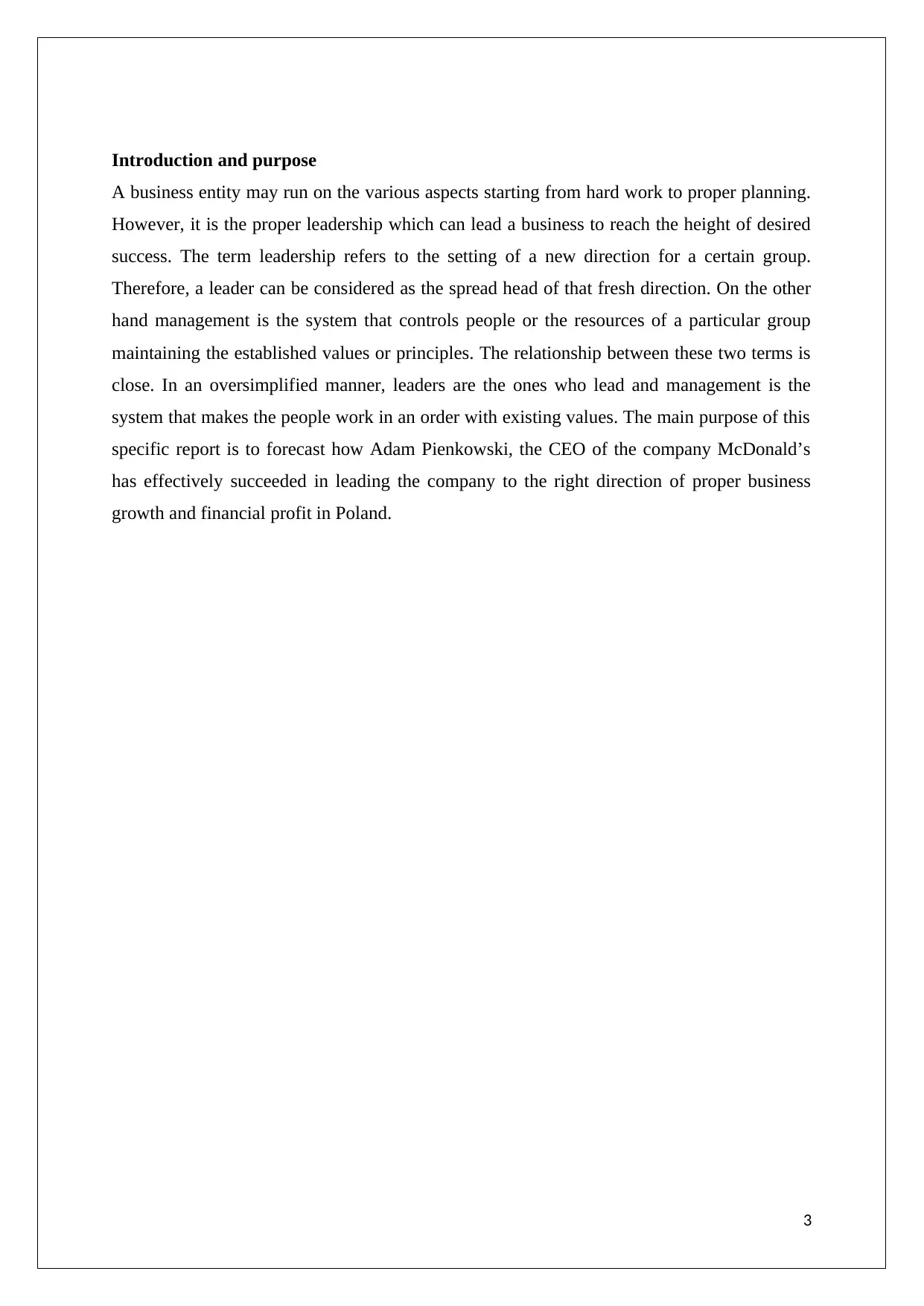
Introduction and purpose
A business entity may run on the various aspects starting from hard work to proper planning.
However, it is the proper leadership which can lead a business to reach the height of desired
success. The term leadership refers to the setting of a new direction for a certain group.
Therefore, a leader can be considered as the spread head of that fresh direction. On the other
hand management is the system that controls people or the resources of a particular group
maintaining the established values or principles. The relationship between these two terms is
close. In an oversimplified manner, leaders are the ones who lead and management is the
system that makes the people work in an order with existing values. The main purpose of this
specific report is to forecast how Adam Pienkowski, the CEO of the company McDonald’s
has effectively succeeded in leading the company to the right direction of proper business
growth and financial profit in Poland.
3
A business entity may run on the various aspects starting from hard work to proper planning.
However, it is the proper leadership which can lead a business to reach the height of desired
success. The term leadership refers to the setting of a new direction for a certain group.
Therefore, a leader can be considered as the spread head of that fresh direction. On the other
hand management is the system that controls people or the resources of a particular group
maintaining the established values or principles. The relationship between these two terms is
close. In an oversimplified manner, leaders are the ones who lead and management is the
system that makes the people work in an order with existing values. The main purpose of this
specific report is to forecast how Adam Pienkowski, the CEO of the company McDonald’s
has effectively succeeded in leading the company to the right direction of proper business
growth and financial profit in Poland.
3
⊘ This is a preview!⊘
Do you want full access?
Subscribe today to unlock all pages.

Trusted by 1+ million students worldwide
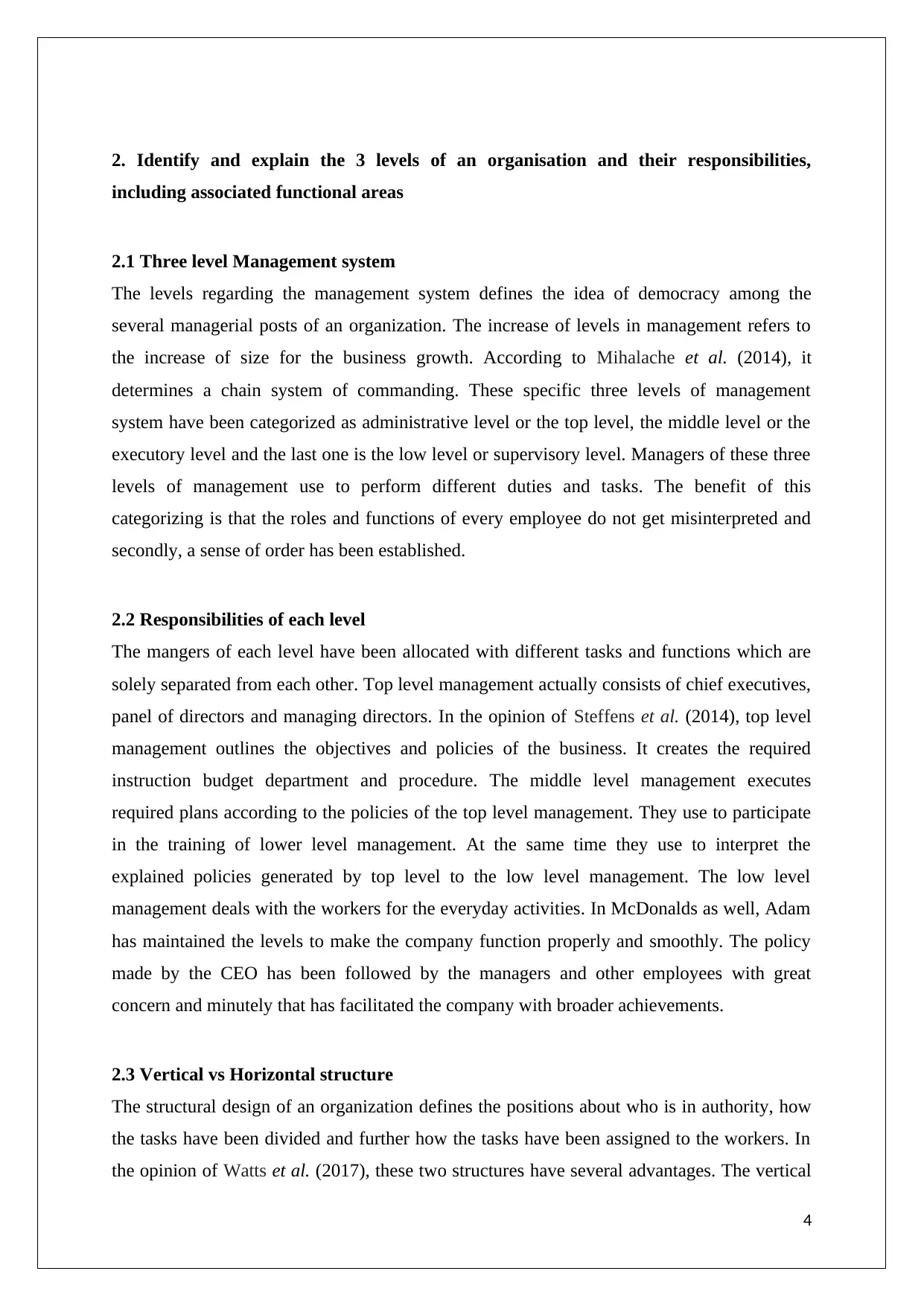
2. Identify and explain the 3 levels of an organisation and their responsibilities,
including associated functional areas
2.1 Three level Management system
The levels regarding the management system defines the idea of democracy among the
several managerial posts of an organization. The increase of levels in management refers to
the increase of size for the business growth. According to Mihalache et al. (2014), it
determines a chain system of commanding. These specific three levels of management
system have been categorized as administrative level or the top level, the middle level or the
executory level and the last one is the low level or supervisory level. Managers of these three
levels of management use to perform different duties and tasks. The benefit of this
categorizing is that the roles and functions of every employee do not get misinterpreted and
secondly, a sense of order has been established.
2.2 Responsibilities of each level
The mangers of each level have been allocated with different tasks and functions which are
solely separated from each other. Top level management actually consists of chief executives,
panel of directors and managing directors. In the opinion of Steffens et al. (2014), top level
management outlines the objectives and policies of the business. It creates the required
instruction budget department and procedure. The middle level management executes
required plans according to the policies of the top level management. They use to participate
in the training of lower level management. At the same time they use to interpret the
explained policies generated by top level to the low level management. The low level
management deals with the workers for the everyday activities. In McDonalds as well, Adam
has maintained the levels to make the company function properly and smoothly. The policy
made by the CEO has been followed by the managers and other employees with great
concern and minutely that has facilitated the company with broader achievements.
2.3 Vertical vs Horizontal structure
The structural design of an organization defines the positions about who is in authority, how
the tasks have been divided and further how the tasks have been assigned to the workers. In
the opinion of Watts et al. (2017), these two structures have several advantages. The vertical
4
including associated functional areas
2.1 Three level Management system
The levels regarding the management system defines the idea of democracy among the
several managerial posts of an organization. The increase of levels in management refers to
the increase of size for the business growth. According to Mihalache et al. (2014), it
determines a chain system of commanding. These specific three levels of management
system have been categorized as administrative level or the top level, the middle level or the
executory level and the last one is the low level or supervisory level. Managers of these three
levels of management use to perform different duties and tasks. The benefit of this
categorizing is that the roles and functions of every employee do not get misinterpreted and
secondly, a sense of order has been established.
2.2 Responsibilities of each level
The mangers of each level have been allocated with different tasks and functions which are
solely separated from each other. Top level management actually consists of chief executives,
panel of directors and managing directors. In the opinion of Steffens et al. (2014), top level
management outlines the objectives and policies of the business. It creates the required
instruction budget department and procedure. The middle level management executes
required plans according to the policies of the top level management. They use to participate
in the training of lower level management. At the same time they use to interpret the
explained policies generated by top level to the low level management. The low level
management deals with the workers for the everyday activities. In McDonalds as well, Adam
has maintained the levels to make the company function properly and smoothly. The policy
made by the CEO has been followed by the managers and other employees with great
concern and minutely that has facilitated the company with broader achievements.
2.3 Vertical vs Horizontal structure
The structural design of an organization defines the positions about who is in authority, how
the tasks have been divided and further how the tasks have been assigned to the workers. In
the opinion of Watts et al. (2017), these two structures have several advantages. The vertical
4
Paraphrase This Document
Need a fresh take? Get an instant paraphrase of this document with our AI Paraphraser
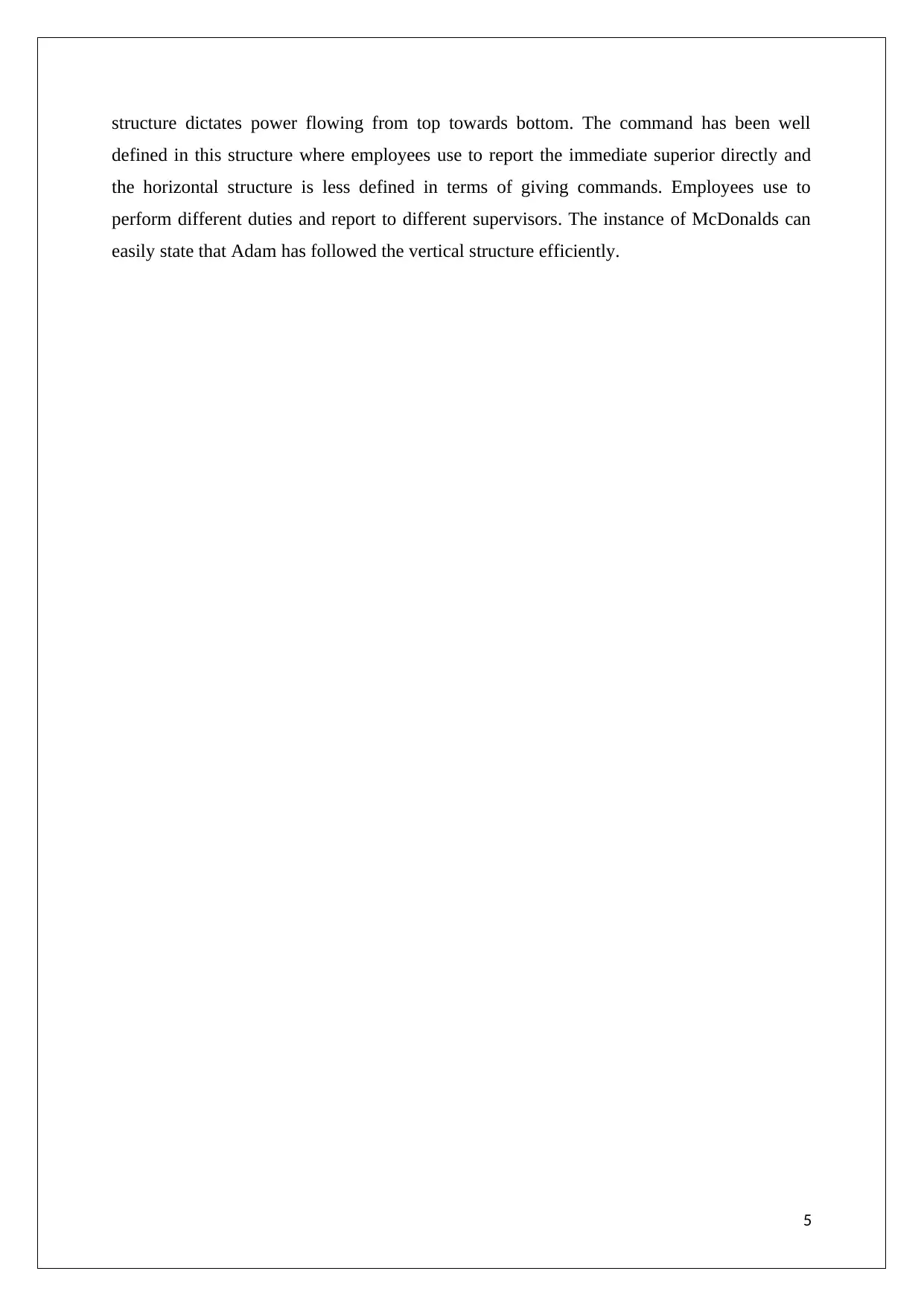
structure dictates power flowing from top towards bottom. The command has been well
defined in this structure where employees use to report the immediate superior directly and
the horizontal structure is less defined in terms of giving commands. Employees use to
perform different duties and report to different supervisors. The instance of McDonalds can
easily state that Adam has followed the vertical structure efficiently.
5
defined in this structure where employees use to report the immediate superior directly and
the horizontal structure is less defined in terms of giving commands. Employees use to
perform different duties and report to different supervisors. The instance of McDonalds can
easily state that Adam has followed the vertical structure efficiently.
5
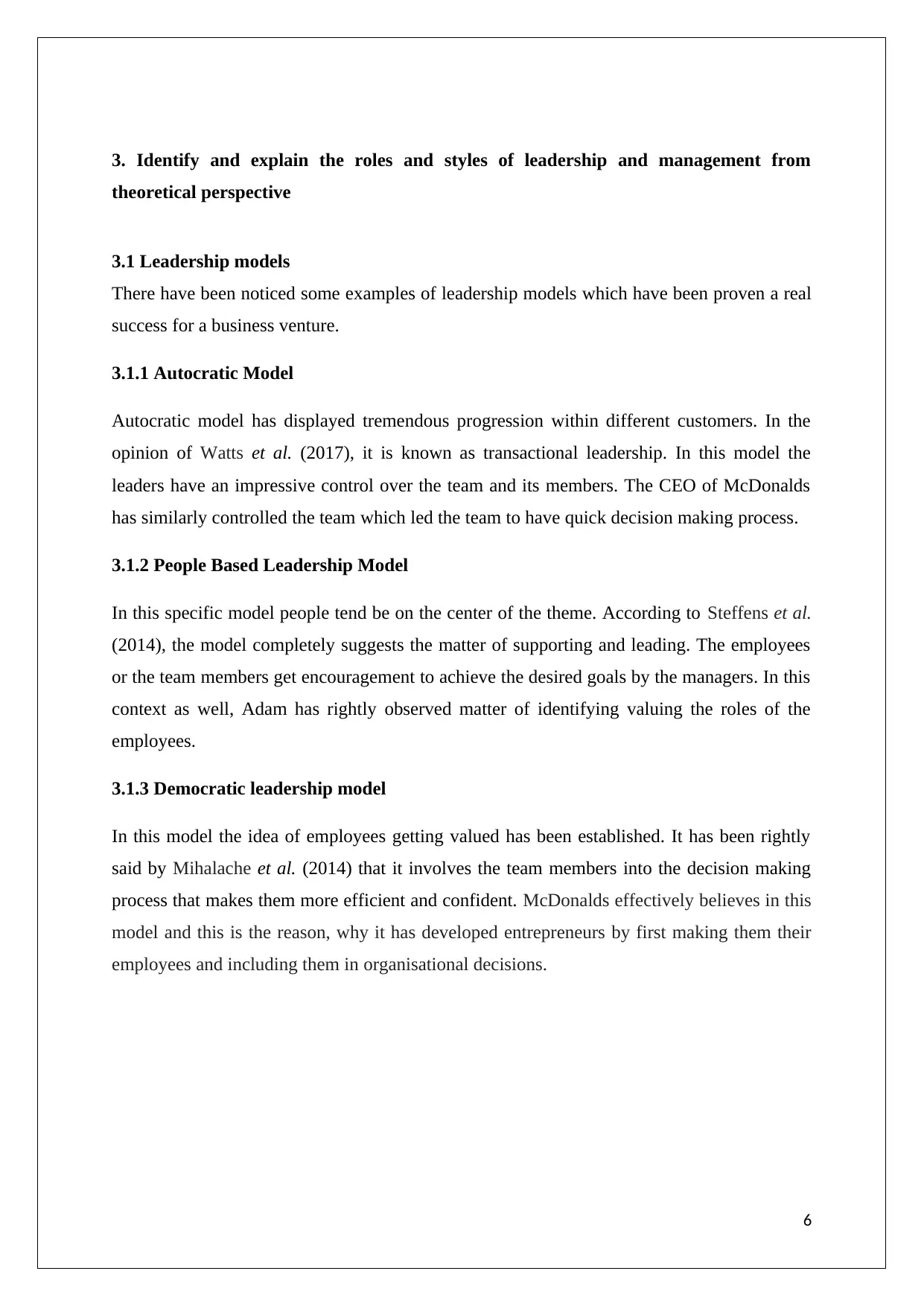
3. Identify and explain the roles and styles of leadership and management from
theoretical perspective
3.1 Leadership models
There have been noticed some examples of leadership models which have been proven a real
success for a business venture.
3.1.1 Autocratic Model
Autocratic model has displayed tremendous progression within different customers. In the
opinion of Watts et al. (2017), it is known as transactional leadership. In this model the
leaders have an impressive control over the team and its members. The CEO of McDonalds
has similarly controlled the team which led the team to have quick decision making process.
3.1.2 People Based Leadership Model
In this specific model people tend be on the center of the theme. According to Steffens et al.
(2014), the model completely suggests the matter of supporting and leading. The employees
or the team members get encouragement to achieve the desired goals by the managers. In this
context as well, Adam has rightly observed matter of identifying valuing the roles of the
employees.
3.1.3 Democratic leadership model
In this model the idea of employees getting valued has been established. It has been rightly
said by Mihalache et al. (2014) that it involves the team members into the decision making
process that makes them more efficient and confident. McDonalds effectively believes in this
model and this is the reason, why it has developed entrepreneurs by first making them their
employees and including them in organisational decisions.
6
theoretical perspective
3.1 Leadership models
There have been noticed some examples of leadership models which have been proven a real
success for a business venture.
3.1.1 Autocratic Model
Autocratic model has displayed tremendous progression within different customers. In the
opinion of Watts et al. (2017), it is known as transactional leadership. In this model the
leaders have an impressive control over the team and its members. The CEO of McDonalds
has similarly controlled the team which led the team to have quick decision making process.
3.1.2 People Based Leadership Model
In this specific model people tend be on the center of the theme. According to Steffens et al.
(2014), the model completely suggests the matter of supporting and leading. The employees
or the team members get encouragement to achieve the desired goals by the managers. In this
context as well, Adam has rightly observed matter of identifying valuing the roles of the
employees.
3.1.3 Democratic leadership model
In this model the idea of employees getting valued has been established. It has been rightly
said by Mihalache et al. (2014) that it involves the team members into the decision making
process that makes them more efficient and confident. McDonalds effectively believes in this
model and this is the reason, why it has developed entrepreneurs by first making them their
employees and including them in organisational decisions.
6
⊘ This is a preview!⊘
Do you want full access?
Subscribe today to unlock all pages.

Trusted by 1+ million students worldwide
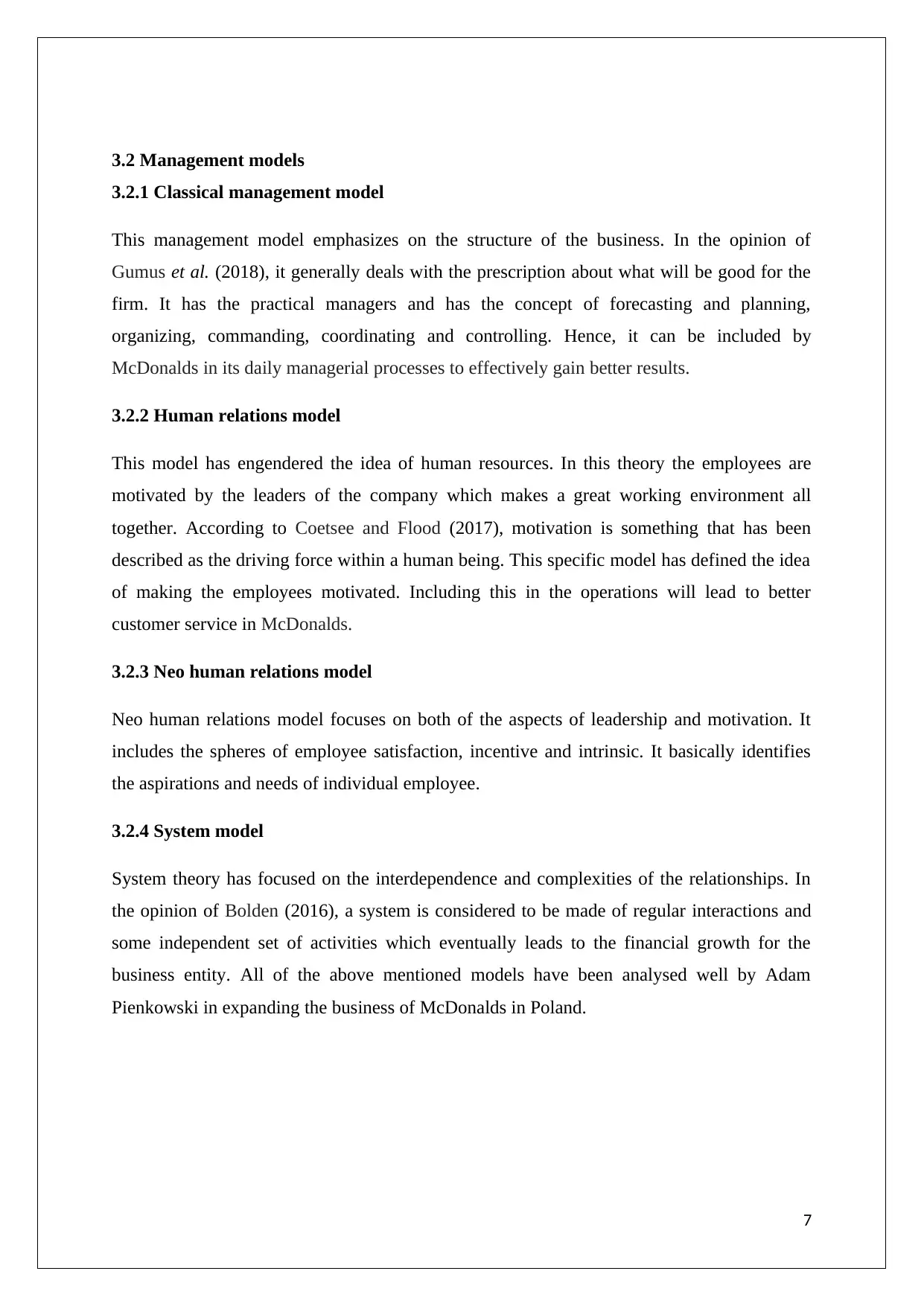
3.2 Management models
3.2.1 Classical management model
This management model emphasizes on the structure of the business. In the opinion of
Gumus et al. (2018), it generally deals with the prescription about what will be good for the
firm. It has the practical managers and has the concept of forecasting and planning,
organizing, commanding, coordinating and controlling. Hence, it can be included by
McDonalds in its daily managerial processes to effectively gain better results.
3.2.2 Human relations model
This model has engendered the idea of human resources. In this theory the employees are
motivated by the leaders of the company which makes a great working environment all
together. According to Coetsee and Flood (2017), motivation is something that has been
described as the driving force within a human being. This specific model has defined the idea
of making the employees motivated. Including this in the operations will lead to better
customer service in McDonalds.
3.2.3 Neo human relations model
Neo human relations model focuses on both of the aspects of leadership and motivation. It
includes the spheres of employee satisfaction, incentive and intrinsic. It basically identifies
the aspirations and needs of individual employee.
3.2.4 System model
System theory has focused on the interdependence and complexities of the relationships. In
the opinion of Bolden (2016), a system is considered to be made of regular interactions and
some independent set of activities which eventually leads to the financial growth for the
business entity. All of the above mentioned models have been analysed well by Adam
Pienkowski in expanding the business of McDonalds in Poland.
7
3.2.1 Classical management model
This management model emphasizes on the structure of the business. In the opinion of
Gumus et al. (2018), it generally deals with the prescription about what will be good for the
firm. It has the practical managers and has the concept of forecasting and planning,
organizing, commanding, coordinating and controlling. Hence, it can be included by
McDonalds in its daily managerial processes to effectively gain better results.
3.2.2 Human relations model
This model has engendered the idea of human resources. In this theory the employees are
motivated by the leaders of the company which makes a great working environment all
together. According to Coetsee and Flood (2017), motivation is something that has been
described as the driving force within a human being. This specific model has defined the idea
of making the employees motivated. Including this in the operations will lead to better
customer service in McDonalds.
3.2.3 Neo human relations model
Neo human relations model focuses on both of the aspects of leadership and motivation. It
includes the spheres of employee satisfaction, incentive and intrinsic. It basically identifies
the aspirations and needs of individual employee.
3.2.4 System model
System theory has focused on the interdependence and complexities of the relationships. In
the opinion of Bolden (2016), a system is considered to be made of regular interactions and
some independent set of activities which eventually leads to the financial growth for the
business entity. All of the above mentioned models have been analysed well by Adam
Pienkowski in expanding the business of McDonalds in Poland.
7
Paraphrase This Document
Need a fresh take? Get an instant paraphrase of this document with our AI Paraphraser
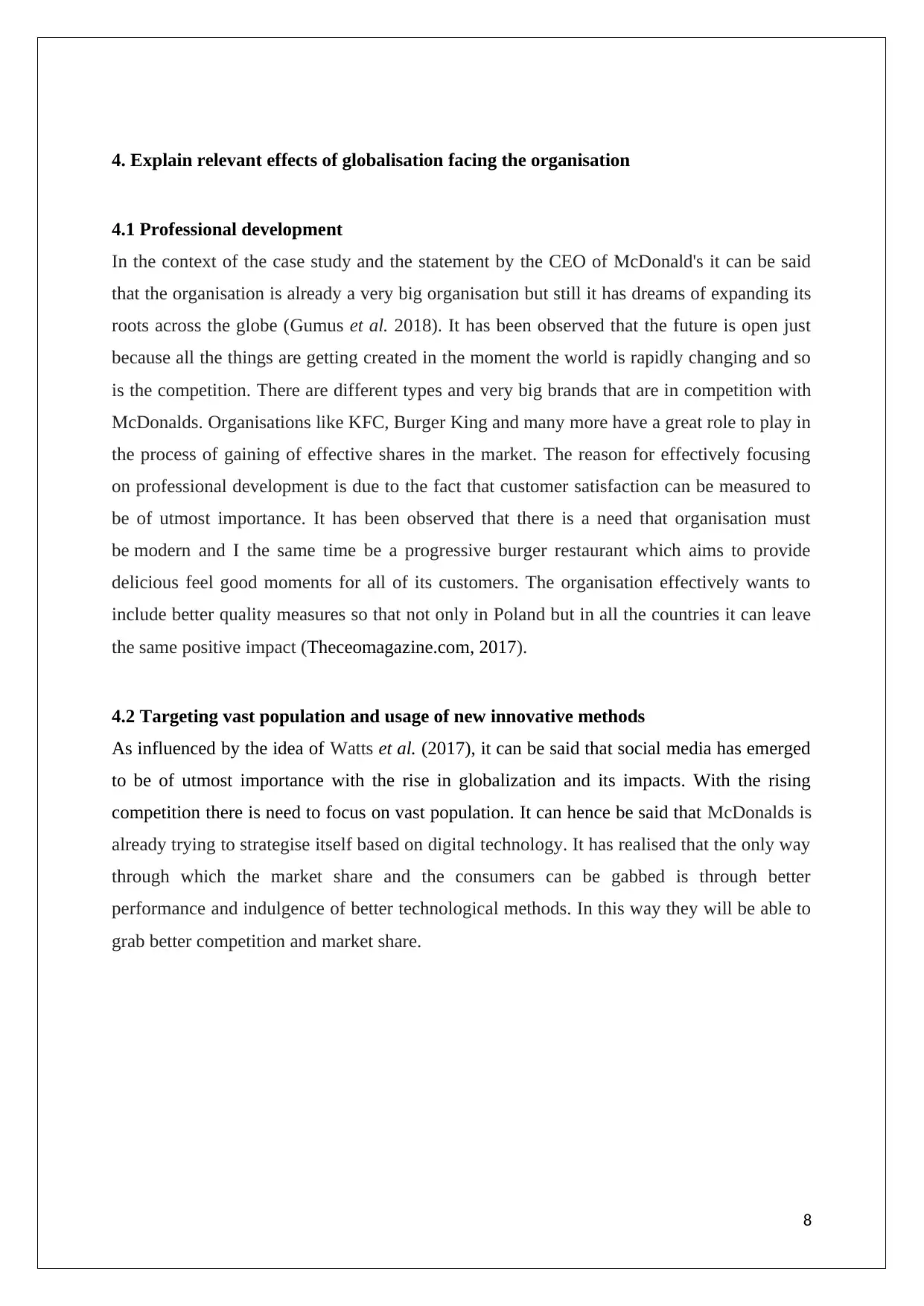
4. Explain relevant effects of globalisation facing the organisation
4.1 Professional development
In the context of the case study and the statement by the CEO of McDonald's it can be said
that the organisation is already a very big organisation but still it has dreams of expanding its
roots across the globe (Gumus et al. 2018). It has been observed that the future is open just
because all the things are getting created in the moment the world is rapidly changing and so
is the competition. There are different types and very big brands that are in competition with
McDonalds. Organisations like KFC, Burger King and many more have a great role to play in
the process of gaining of effective shares in the market. The reason for effectively focusing
on professional development is due to the fact that customer satisfaction can be measured to
be of utmost importance. It has been observed that there is a need that organisation must
be modern and I the same time be a progressive burger restaurant which aims to provide
delicious feel good moments for all of its customers. The organisation effectively wants to
include better quality measures so that not only in Poland but in all the countries it can leave
the same positive impact (Theceomagazine.com, 2017).
4.2 Targeting vast population and usage of new innovative methods
As influenced by the idea of Watts et al. (2017), it can be said that social media has emerged
to be of utmost importance with the rise in globalization and its impacts. With the rising
competition there is need to focus on vast population. It can hence be said that McDonalds is
already trying to strategise itself based on digital technology. It has realised that the only way
through which the market share and the consumers can be gabbed is through better
performance and indulgence of better technological methods. In this way they will be able to
grab better competition and market share.
8
4.1 Professional development
In the context of the case study and the statement by the CEO of McDonald's it can be said
that the organisation is already a very big organisation but still it has dreams of expanding its
roots across the globe (Gumus et al. 2018). It has been observed that the future is open just
because all the things are getting created in the moment the world is rapidly changing and so
is the competition. There are different types and very big brands that are in competition with
McDonalds. Organisations like KFC, Burger King and many more have a great role to play in
the process of gaining of effective shares in the market. The reason for effectively focusing
on professional development is due to the fact that customer satisfaction can be measured to
be of utmost importance. It has been observed that there is a need that organisation must
be modern and I the same time be a progressive burger restaurant which aims to provide
delicious feel good moments for all of its customers. The organisation effectively wants to
include better quality measures so that not only in Poland but in all the countries it can leave
the same positive impact (Theceomagazine.com, 2017).
4.2 Targeting vast population and usage of new innovative methods
As influenced by the idea of Watts et al. (2017), it can be said that social media has emerged
to be of utmost importance with the rise in globalization and its impacts. With the rising
competition there is need to focus on vast population. It can hence be said that McDonalds is
already trying to strategise itself based on digital technology. It has realised that the only way
through which the market share and the consumers can be gabbed is through better
performance and indulgence of better technological methods. In this way they will be able to
grab better competition and market share.
8
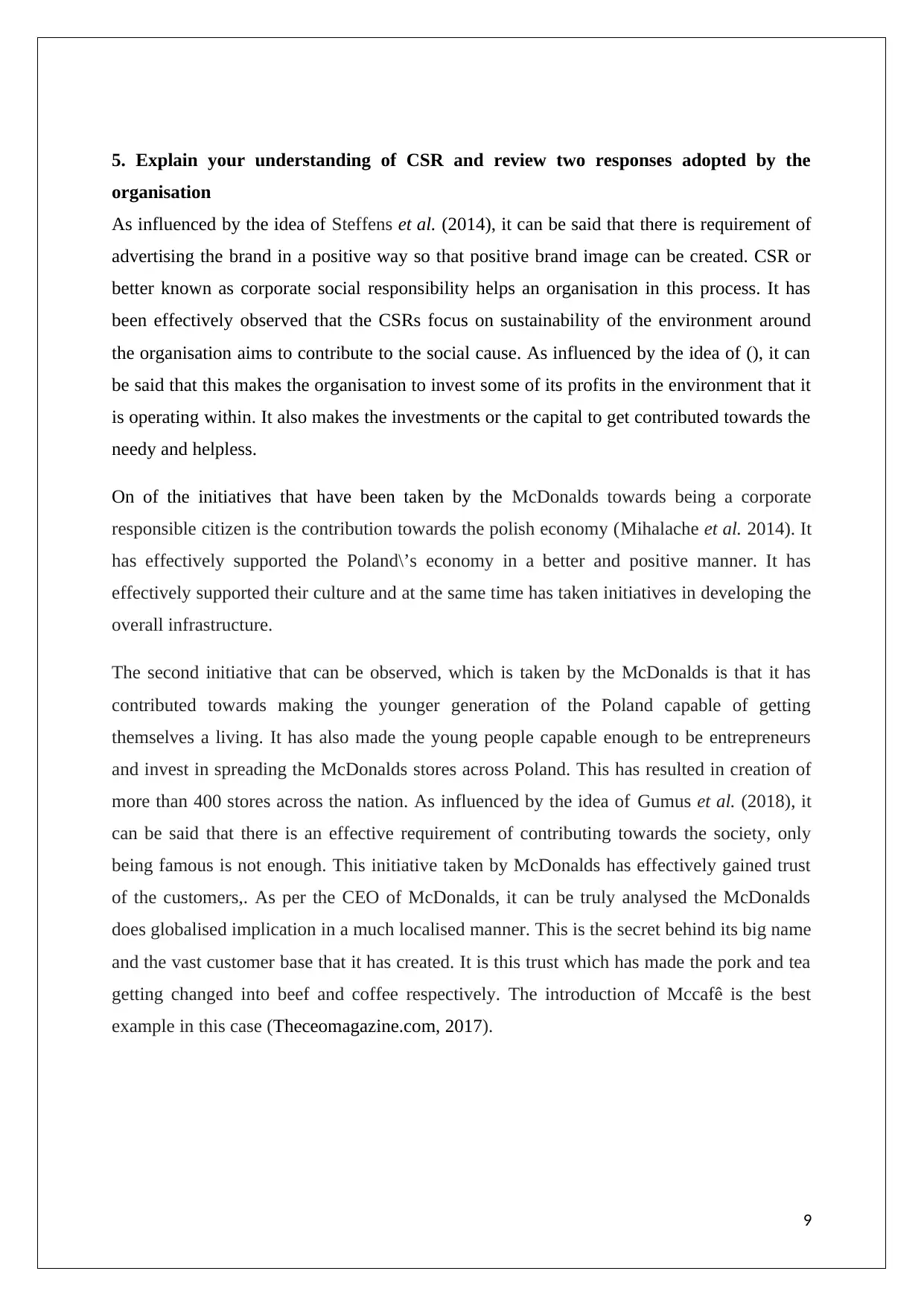
5. Explain your understanding of CSR and review two responses adopted by the
organisation
As influenced by the idea of Steffens et al. (2014), it can be said that there is requirement of
advertising the brand in a positive way so that positive brand image can be created. CSR or
better known as corporate social responsibility helps an organisation in this process. It has
been effectively observed that the CSRs focus on sustainability of the environment around
the organisation aims to contribute to the social cause. As influenced by the idea of (), it can
be said that this makes the organisation to invest some of its profits in the environment that it
is operating within. It also makes the investments or the capital to get contributed towards the
needy and helpless.
On of the initiatives that have been taken by the McDonalds towards being a corporate
responsible citizen is the contribution towards the polish economy (Mihalache et al. 2014). It
has effectively supported the Poland\’s economy in a better and positive manner. It has
effectively supported their culture and at the same time has taken initiatives in developing the
overall infrastructure.
The second initiative that can be observed, which is taken by the McDonalds is that it has
contributed towards making the younger generation of the Poland capable of getting
themselves a living. It has also made the young people capable enough to be entrepreneurs
and invest in spreading the McDonalds stores across Poland. This has resulted in creation of
more than 400 stores across the nation. As influenced by the idea of Gumus et al. (2018), it
can be said that there is an effective requirement of contributing towards the society, only
being famous is not enough. This initiative taken by McDonalds has effectively gained trust
of the customers,. As per the CEO of McDonalds, it can be truly analysed the McDonalds
does globalised implication in a much localised manner. This is the secret behind its big name
and the vast customer base that it has created. It is this trust which has made the pork and tea
getting changed into beef and coffee respectively. The introduction of Mccafê is the best
example in this case (Theceomagazine.com, 2017).
9
organisation
As influenced by the idea of Steffens et al. (2014), it can be said that there is requirement of
advertising the brand in a positive way so that positive brand image can be created. CSR or
better known as corporate social responsibility helps an organisation in this process. It has
been effectively observed that the CSRs focus on sustainability of the environment around
the organisation aims to contribute to the social cause. As influenced by the idea of (), it can
be said that this makes the organisation to invest some of its profits in the environment that it
is operating within. It also makes the investments or the capital to get contributed towards the
needy and helpless.
On of the initiatives that have been taken by the McDonalds towards being a corporate
responsible citizen is the contribution towards the polish economy (Mihalache et al. 2014). It
has effectively supported the Poland\’s economy in a better and positive manner. It has
effectively supported their culture and at the same time has taken initiatives in developing the
overall infrastructure.
The second initiative that can be observed, which is taken by the McDonalds is that it has
contributed towards making the younger generation of the Poland capable of getting
themselves a living. It has also made the young people capable enough to be entrepreneurs
and invest in spreading the McDonalds stores across Poland. This has resulted in creation of
more than 400 stores across the nation. As influenced by the idea of Gumus et al. (2018), it
can be said that there is an effective requirement of contributing towards the society, only
being famous is not enough. This initiative taken by McDonalds has effectively gained trust
of the customers,. As per the CEO of McDonalds, it can be truly analysed the McDonalds
does globalised implication in a much localised manner. This is the secret behind its big name
and the vast customer base that it has created. It is this trust which has made the pork and tea
getting changed into beef and coffee respectively. The introduction of Mccafê is the best
example in this case (Theceomagazine.com, 2017).
9
⊘ This is a preview!⊘
Do you want full access?
Subscribe today to unlock all pages.

Trusted by 1+ million students worldwide
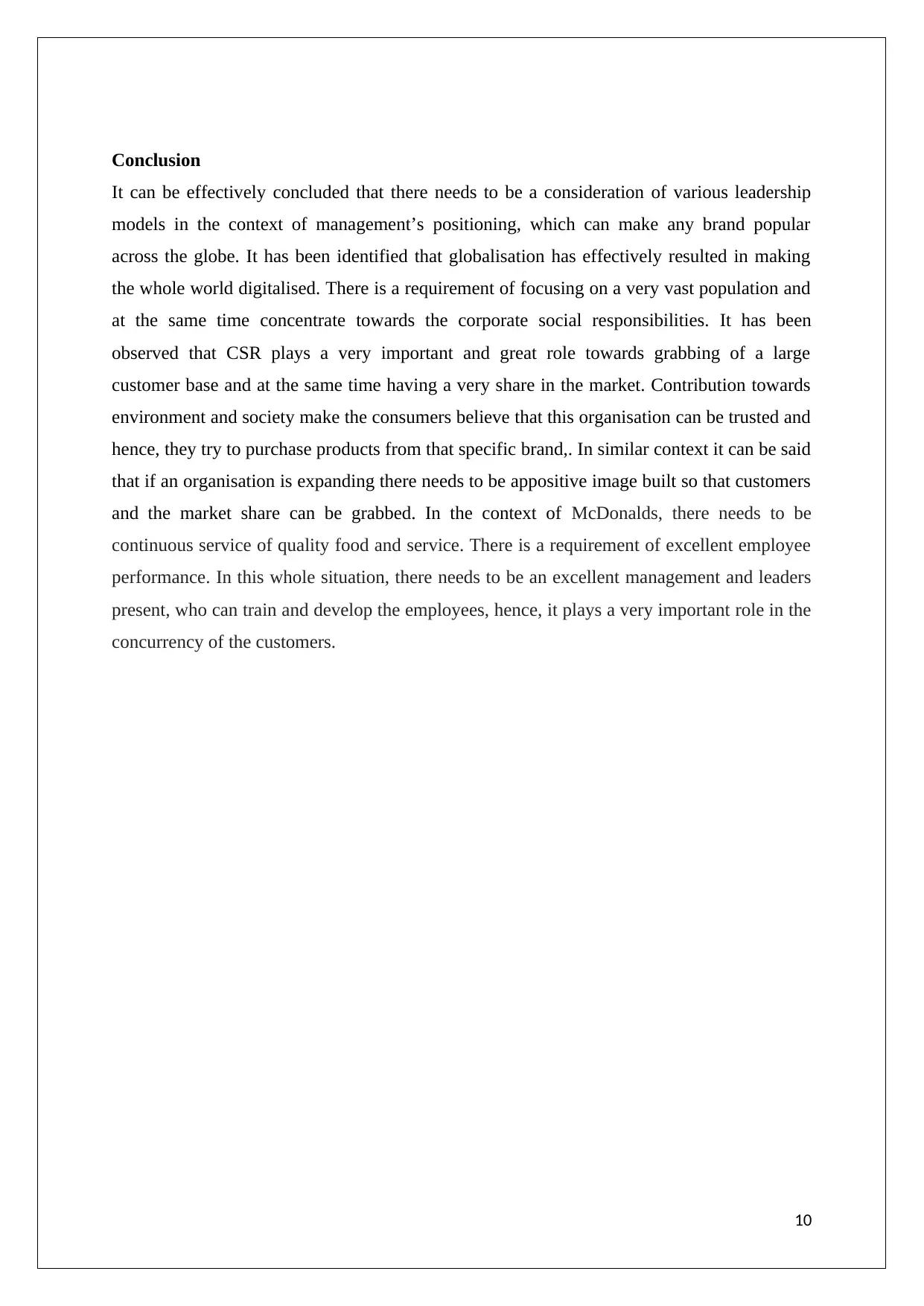
Conclusion
It can be effectively concluded that there needs to be a consideration of various leadership
models in the context of management’s positioning, which can make any brand popular
across the globe. It has been identified that globalisation has effectively resulted in making
the whole world digitalised. There is a requirement of focusing on a very vast population and
at the same time concentrate towards the corporate social responsibilities. It has been
observed that CSR plays a very important and great role towards grabbing of a large
customer base and at the same time having a very share in the market. Contribution towards
environment and society make the consumers believe that this organisation can be trusted and
hence, they try to purchase products from that specific brand,. In similar context it can be said
that if an organisation is expanding there needs to be appositive image built so that customers
and the market share can be grabbed. In the context of McDonalds, there needs to be
continuous service of quality food and service. There is a requirement of excellent employee
performance. In this whole situation, there needs to be an excellent management and leaders
present, who can train and develop the employees, hence, it plays a very important role in the
concurrency of the customers.
10
It can be effectively concluded that there needs to be a consideration of various leadership
models in the context of management’s positioning, which can make any brand popular
across the globe. It has been identified that globalisation has effectively resulted in making
the whole world digitalised. There is a requirement of focusing on a very vast population and
at the same time concentrate towards the corporate social responsibilities. It has been
observed that CSR plays a very important and great role towards grabbing of a large
customer base and at the same time having a very share in the market. Contribution towards
environment and society make the consumers believe that this organisation can be trusted and
hence, they try to purchase products from that specific brand,. In similar context it can be said
that if an organisation is expanding there needs to be appositive image built so that customers
and the market share can be grabbed. In the context of McDonalds, there needs to be
continuous service of quality food and service. There is a requirement of excellent employee
performance. In this whole situation, there needs to be an excellent management and leaders
present, who can train and develop the employees, hence, it plays a very important role in the
concurrency of the customers.
10
Paraphrase This Document
Need a fresh take? Get an instant paraphrase of this document with our AI Paraphraser
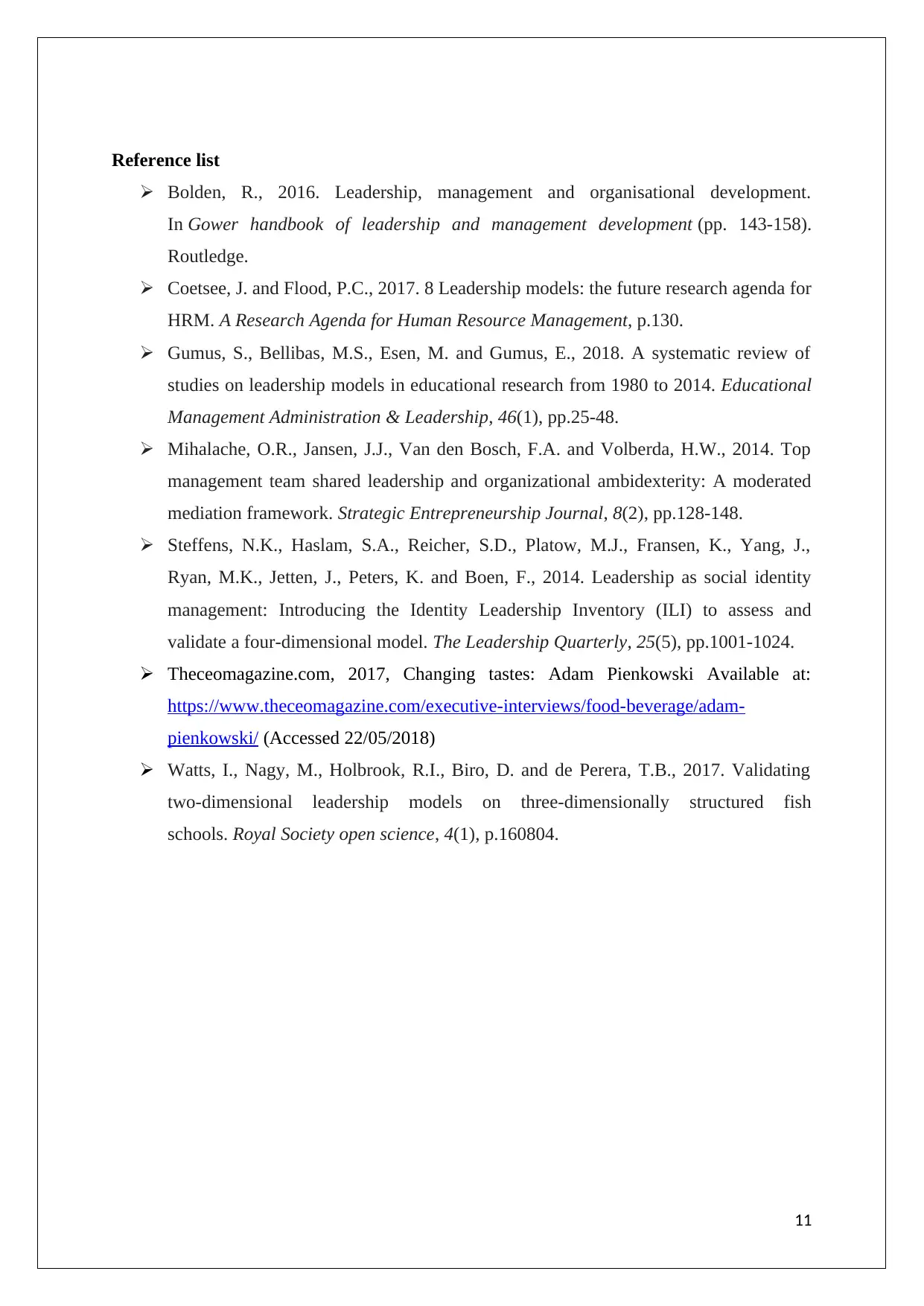
Reference list
Bolden, R., 2016. Leadership, management and organisational development.
In Gower handbook of leadership and management development (pp. 143-158).
Routledge.
Coetsee, J. and Flood, P.C., 2017. 8 Leadership models: the future research agenda for
HRM. A Research Agenda for Human Resource Management, p.130.
Gumus, S., Bellibas, M.S., Esen, M. and Gumus, E., 2018. A systematic review of
studies on leadership models in educational research from 1980 to 2014. Educational
Management Administration & Leadership, 46(1), pp.25-48.
Mihalache, O.R., Jansen, J.J., Van den Bosch, F.A. and Volberda, H.W., 2014. Top
management team shared leadership and organizational ambidexterity: A moderated
mediation framework. Strategic Entrepreneurship Journal, 8(2), pp.128-148.
Steffens, N.K., Haslam, S.A., Reicher, S.D., Platow, M.J., Fransen, K., Yang, J.,
Ryan, M.K., Jetten, J., Peters, K. and Boen, F., 2014. Leadership as social identity
management: Introducing the Identity Leadership Inventory (ILI) to assess and
validate a four-dimensional model. The Leadership Quarterly, 25(5), pp.1001-1024.
Theceomagazine.com, 2017, Changing tastes: Adam Pienkowski Available at:
https://www.theceomagazine.com/executive-interviews/food-beverage/adam-
pienkowski/ (Accessed 22/05/2018)
Watts, I., Nagy, M., Holbrook, R.I., Biro, D. and de Perera, T.B., 2017. Validating
two-dimensional leadership models on three-dimensionally structured fish
schools. Royal Society open science, 4(1), p.160804.
11
Bolden, R., 2016. Leadership, management and organisational development.
In Gower handbook of leadership and management development (pp. 143-158).
Routledge.
Coetsee, J. and Flood, P.C., 2017. 8 Leadership models: the future research agenda for
HRM. A Research Agenda for Human Resource Management, p.130.
Gumus, S., Bellibas, M.S., Esen, M. and Gumus, E., 2018. A systematic review of
studies on leadership models in educational research from 1980 to 2014. Educational
Management Administration & Leadership, 46(1), pp.25-48.
Mihalache, O.R., Jansen, J.J., Van den Bosch, F.A. and Volberda, H.W., 2014. Top
management team shared leadership and organizational ambidexterity: A moderated
mediation framework. Strategic Entrepreneurship Journal, 8(2), pp.128-148.
Steffens, N.K., Haslam, S.A., Reicher, S.D., Platow, M.J., Fransen, K., Yang, J.,
Ryan, M.K., Jetten, J., Peters, K. and Boen, F., 2014. Leadership as social identity
management: Introducing the Identity Leadership Inventory (ILI) to assess and
validate a four-dimensional model. The Leadership Quarterly, 25(5), pp.1001-1024.
Theceomagazine.com, 2017, Changing tastes: Adam Pienkowski Available at:
https://www.theceomagazine.com/executive-interviews/food-beverage/adam-
pienkowski/ (Accessed 22/05/2018)
Watts, I., Nagy, M., Holbrook, R.I., Biro, D. and de Perera, T.B., 2017. Validating
two-dimensional leadership models on three-dimensionally structured fish
schools. Royal Society open science, 4(1), p.160804.
11
1 out of 11
Related Documents
Your All-in-One AI-Powered Toolkit for Academic Success.
+13062052269
info@desklib.com
Available 24*7 on WhatsApp / Email
![[object Object]](/_next/static/media/star-bottom.7253800d.svg)
Unlock your academic potential
Copyright © 2020–2025 A2Z Services. All Rights Reserved. Developed and managed by ZUCOL.





